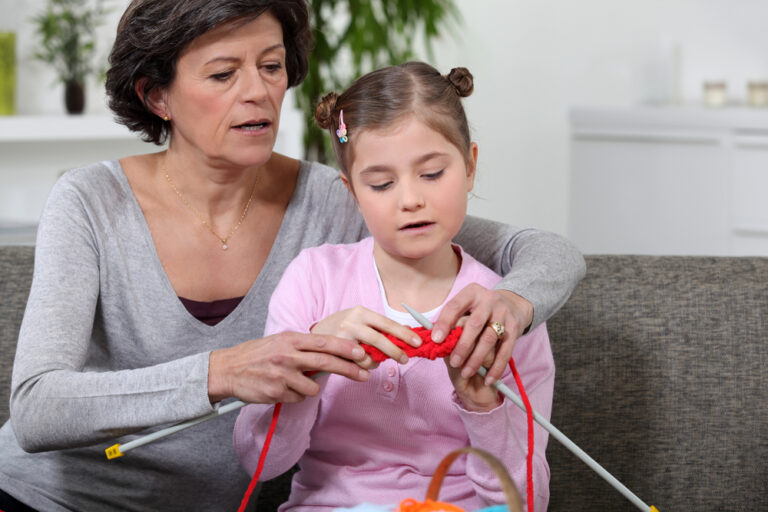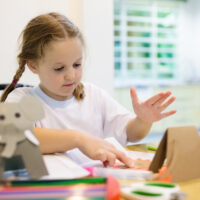Maybe you enjoy the wonderful hobby of knitting (or your child has asked to learn), and you are wondering how to teach your child to knit. It is a fun and useful skill to have, and children are definitely capable of learning! I have some basic knitting skills, but my husband is actually the superior knitter in our home. With our experience, I can share with you tips to help get your child started.
Are they Ready?
Knitting takes patience to learn and a certain amount of fine motor skills. If your child is on the younger side, consider if they have the stamina to learn. If you try to teach a child who doesn’t want to learn or who is easily frustrated, it will probably be an unpleasant experience for you both.
If you’re not sure knitting is the right choice for your younger crafty child, check out our favorite craft kits for 5, 6, and 7-year-olds.
My oldest daughter did some knitting when she was 6 or 7, but it was kind of tough and she didn’t really stick with it. Now she’s more interested in sewing and crochet. I think for most kids, 8-10 years old is a good range to start teaching a child who is interested.
Get the Right Supplies
You don’t need a lot of supplies to get started, but you will need a pair of knitting needles and some yarn. You might want a medium to larger size needle for smaller hands, like a 6 or an 8. Wooden needles might be easiest as they aren’t as slippery as metal or plastic needles can be.
Besides traditional needle knitting, knit projects can be created with looms or just with your fingers. I have suggested kits with supplies for these variations below.
I would recommend you let your child pick what color yarn they would like to start with. There are a wide variety of qualities of yarn. You don’t need to spend a lot of money on yarn that’s mostly to practice on. Cotton or wool might be less slippery to work with for a beginner than acrylic, though.
Start with the Basics
The knit stitch is the perfect place to start. If possible, cast on a row of stitches for your child so they can gain some confidence with knit stitches before trying the cast on.
It is probably easiest if you can demonstrate the knit stitch for your child or find someone who can teach them personally.
But we are lucky to live in the age of YouTube because learning to knit by following along with a video is far easier than following a book or other printed instructions! My husband has some videos he calls up whenever he needs a specialty stitch he hasn’t used enough to have memorized.
Basically, for a knit stitch, you put the right needle into the end loop on the left needle from the front to the back, then wrap the yarn end counter-clockwise around the right needle and pull it back through the original loop while transferring your new loop onto the right needle.
The next stitch to master would be a purl stitch. To purl, you put the right needle into the loop on the left needle from the back to the front, wrap the yarn end around it counterclockwise, and pull it back through the original loop.
With these two stitches learned, your child can make so many things!
Learn to Cast On and Bind Off
Once your child is confident with the basic stitches, you can show them how to begin and end projects. To start a project, you cast the yarn onto one of the needles. There are many different ways to cast on, but a very basic one will suffice for beginners.
When all the stitches for a project are done, you bind it off to weave the loose yarn through the final stitches and secure them. If your child just slips live stitches off of the needle, the entire project will unravel! So it is important that they know there is a special step do to at the end.
With these skills, your child could make a washcloth, scarf, small blanket, or anything that’s flat and rectangular.
Practice Reading Patterns
When your child wants to make something more complicated, they will probably need to follow a pattern. Patterns are the instructions for a knitting project. They will tell you how long to make a row, which stitches to place where, and how many rows are needed.
There are abbreviations and symbols used in knitting patterns that may take some work to understand at the beginning. Look at some patterns you have or some free ones online to explain the different parts of a pattern and how to read one.
Then let your child pick a beginner-friendly pattern to try. Encourage them to start simple to build confidence. As they progress from flat projects, they can start to make clothes or stuffed animals. But these take good pattern reading skills (or excellent spatial relations and planning to create it yourself).
Benefits of Teaching a Child to Knit
There are many benefits for a child who knows how to knit.
Hand-eye Coordination
Whether your child learns traditional knitting or looms or finger knitting, they will be improving their hand-eye coordination as they learn to join the yarn loops to create something. Knitting also will help develop fine motor skills in the fingers.
Creativity
Knitting is a way to nurture your child’s creativity. Once they get the basics, there is a lot of room to design their own creations or modify patterns to match their favorite colors or styles. Your child can enjoy making a variety of projects for themselves and others.
No Screen Time
Many parents are looking for ways to occupy their children without screens. While YouTube may be a good resource for learning to knit, once the basics are mastered, no screens are involved in continuing to knit! Your child can get a lot of pleasure out of actively making something rather than passively being entertained.
Self-sufficiency
Once basic knitting skills are mastered, your child will be capable of making many things for the rest of their life rather than having to buy them. Many different clothing and winter items can be knit as well as blankets, stuffed animals, and decorative items. Being able to make these things is one way a child can become more self-sufficient.
Psychological/Social Well-being
In a study of adult knitters, researchers found that knitting has “significant psychological and social benefits.” More frequent knitters reported higher cognitive functioning as well as more feelings of calmness and happiness. While the study didn’t include children, these benefits may apply to them as well.
Also, the time you spend teaching your child to knit will benefit both of you as you spend more time together. If knitting is one of your hobbies, teaching your child to knit can give you a common interest for the rest of your life. My husband and his mom regularly talk about their knitting projects and various techniques.
Sale Potential
Handmade crafts are popular these days, as platforms like Etsy show us. If your child becomes a superior knitter, they could sell handmade items online or locally (with your help, of course). It could be more profitable than a lemonade stand!
Products that May Help Teach a Child to Knit
There are many options when it comes to buying knitting needles and yarn to get started. Here are just a few aimed at children:
Galt Toys First Knitting Arts & Craft includes wooden knitting needles, plus a pom-pom maker and a French knitter for making cords. The included projects are a bag, purse, and pom-pom scarf. But the needles, pom-pom maker, and knitter can be used for many more creations with some additional yarn.
4M Easy-to-do Knitting Art Kit includes plastic knitting needles and enough yarn for three projects: a bag, pillow, and iPod holder. We have some other 4M kits for kids, and they have been well done.
There are also ways to knit that don’t involve the traditional needles. These could be good ways to get a child started in the world of knitting.
Creativity for Kids Quick Knit Loom includes a loom that is used to make knit projects rather than needles. These are a great way to make hats, but there are other projects that can be done with them as well.
Craftabelle – Finger Knit Creation Kit – Beginner Knitting Kit will help teach your child how to do finger knitting, where the yarn is wrapped around their fingers instead of needles to create the loops.
Conclusion
Whether you teach your child to knit yourself or find a class or YouTube channel to help, I hope you will help your child learn to knit. It is a fun hobby that’s also a very useful skill for those who progress to making clothing and household items. It will take time and patience, but your child can become a proficient knitter.






